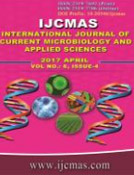


 National Academy of Agricultural Sciences (NAAS)
National Academy of Agricultural Sciences (NAAS)

|
PRINT ISSN : 2319-7692
Online ISSN : 2319-7706 Issues : 12 per year Publisher : Excellent Publishers Email : editorijcmas@gmail.com / submit@ijcmas.com Editor-in-chief: Dr.M.Prakash Index Copernicus ICV 2018: 95.39 NAAS RATING 2020: 5.38 |
Chilli fruit rot disease samples were collected from Guntur, Krishna, Prakasam, Kurnool and Chittoor districts of Andhra Pradesh. Standard blotter method was used to know the Per cent infection of mycoflora associated with chilli seed. Highest (54.20%) mean per cent infection of mycoflora was observed in Guntur district while the lowest (39.70%) mean per cent incidence was observed in Chittoor district. The most commonly found mycoflora were Colletotrichum capsici, C. gloeosporioides, Cercospora spp., Fusarium spp., Alternaria spp., Penicillium spp. and Aspergillus spp. Among the different fungi associated with chilli fruit rot, C. capsici found with highest per cent infection (64.53%) on seeds.
 |
 |
 |
 |
 |